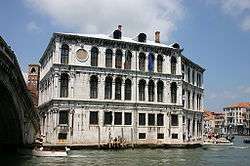Palazzo dei Camerlenghi

Palazzo dei Camerlenghi is a Renaissance palace in Venice, northern Italy, located in the sestiere (quarter) of San Polo. It faces the Canal Grande, adjacent to the Rialto Bridge.
History
.jpg)
The palace was built in the fifteenth century and finished in 1488.[1] From 1525 to 1528 it was enlarges under design by Guglielmo dei Grigi, who was inspired by the style of Mauro Codussi and Pietro Lombardo. It was the seat of several financial magistrates, including the Camerlenghi whom it takes its name from, the Consuls of the Traders and the Supra-Consuls of the Traders. Due to this function, the lower floor was used as a jail for the insolvents: the location nearby the crowded Rialto Bridge served as an admonition for the people passing there.
The palace currently houses the regional seat of the Italian Comptroller and Auditor General.
_-_BEIC_6329396.jpg)
Description
The palace has a pentagonal plan which follows the shore of the Canal Grande, with three floors. It has tall windows with centrings, divided by false columns and decorated with friezes. There were once polychrome marble and porphyry slabs, now lost.The medallion on the facade once incorporated a painted St. Marks lion.[2]
Due to the Venetian tradition that, when leaving the position, a magistrate would leave a religious-themed painting and a portrait in his former seat, the Palazzo dei Camerlenghi housed numerous artworks.[3] Sometimes these paintings expressed although social-political notions of civic virtue.[4] These were dispersed during the French occupation; some returned to Venice, mostly to Gallerie dell'Accademia.
See also
Sources
- Brusegan, Marcello (2007). I palazzi di Venezia. Newton Compton. pp. 108–109.
- Cottrell, Philip: Corporate Colors: Bonifacio and Tintoretto at the Palazzo Dei Camerlenghi in Venice
- Hamilton, Paul C. The Palazzo dei Camerlenghi in Venice. Journal of the Society of Architectural Historians 42 (1983) 258–271.
- Kölmel, Nicolai: The Queen in the Pawnshop: Shaping Civic Virtues in a Painting for the Palazzo dei Camerlenghi in Venice.In: Burghartz et al: Sites of Mediation. Connected Histories of Places, Processes, and Objects in Europe and Beyond, 1450–1650. Brill, Leiden 2016. doi: 10.1163/9789004325760_006
References
- ↑ Hamilton P.C., “The Palazzo dei Camerlenghi in Venice”, Journal of the Society of Architectural Historians 42 (1983) 258–271.
- ↑ N. Kölmel: The Queen in the Pawnshop: Shaping Civic Virtues in a Painting for the Palazzo dei Camerlenghi in Venice. p.99
- ↑ P. Cottrell: Corporate Colors: Bonifacio and Tintoretto at the Palazzo Dei Camerlenghi in Venice
- ↑ N. Kölmel: The Queen in the Pawnshop: Shaping Civic Virtues in a Painting for the Palazzo dei Camerlenghi in Venice.
Coordinates: 45°26′18″N 12°20′09″E / 45.438341°N 12.335823°E